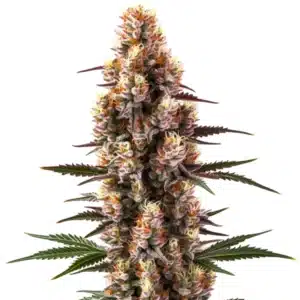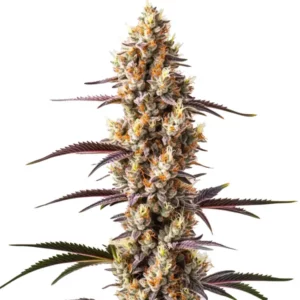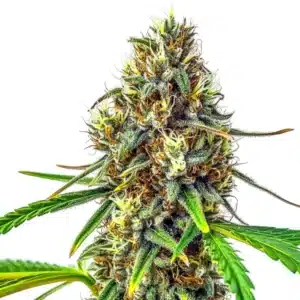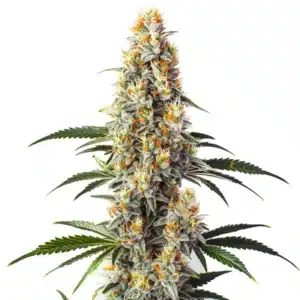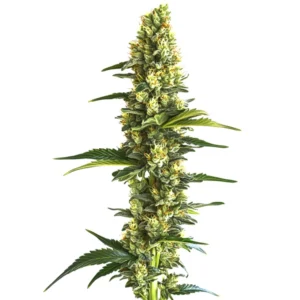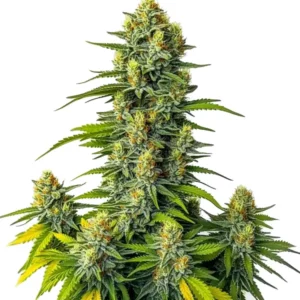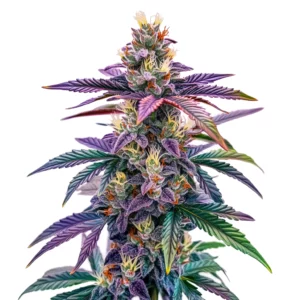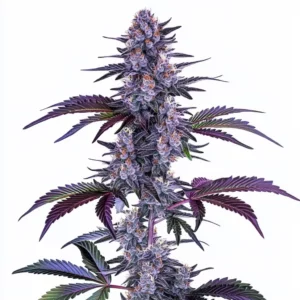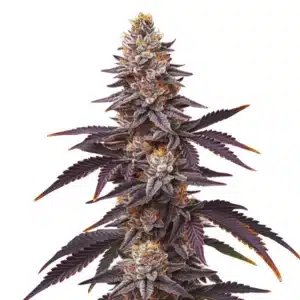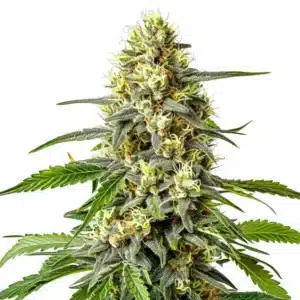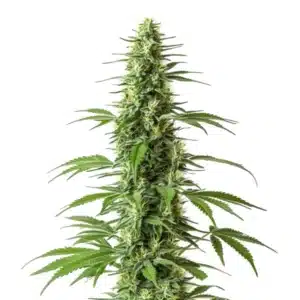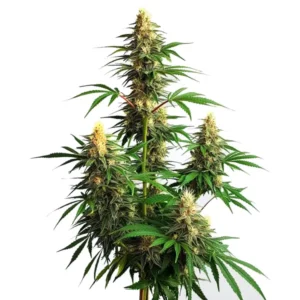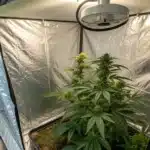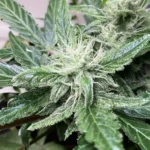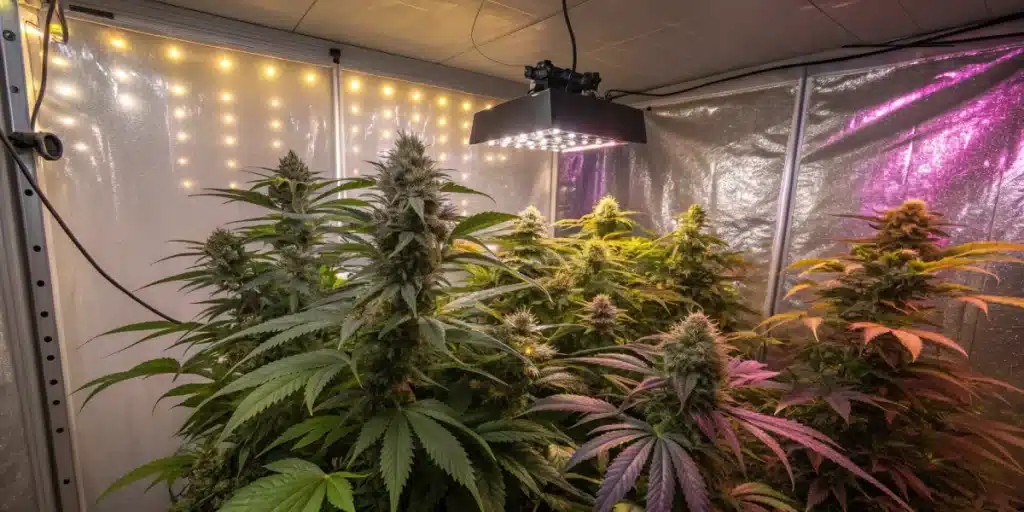
How to Grow Rainbow Kush Autoflowering
Rainbow Kush Autoflowering Description
Rainbow Kush Auto is an autoflowering cannabis strain that delivers a vibrant blend of fruity, spicy, and sweet aromas with a balanced effect. Genetically, it’s the result of a cross between Dancehall, Blueberry, and Ruderalis, and also draws influence from legendary strains like NYC Diesel and Purple Thai—an exotic heritage born from Amsterdam’s prestigious seed banks. This strain has medium THC levels (15%–18%) and very low CBD (around 0.5%), offering euphoric and relaxed sensations without being overpowering.
With a slight Indica dominance (55% Indica / 45% Sativa), Rainbow Kush Auto grows compact and colorful buds that can reach about 4.92 ft (1.5 m) tall. Yields are moderate, ranging from 350–450 gr/m² indoors or 70–120 gr/plant outdoors. Terpenes such as Myrcene, Terpineol, Linalool, and Delta 3 Carene help promote relaxation and sleep, while Alpha-pinene, Beta-pinene, and Eucalyptol contribute anti-inflammatory and respiratory benefits.
Recommended Strains
Rainbow Kush Auto
|
|
THC | 15% - 18% (Medium) |
|
|
Type | Autoflowering |
|
|
Yield | Medium |
|
|
Phenotype | 55% Indica / 45% Sativa |
Rainbow Kush
|
|
THC | 17% - 22% (Medium) |
|
|
Type | Feminized |
|
|
Yield | Medium |
|
|
Phenotype | 50% Indica / 50% Sativa |
Its well-balanced profile and forgiving nature make it ideal for beginners. Plus, thanks to its autoflowering trait, it doesn’t require light cycle changes to bloom, offering faster, more accessible results than traditional feminized strains.
Promos & Deals
Environmental Requirements for Growing Rainbow Kush Autoflowering
Rainbow Kush Auto thrives in controlled, stable environments. Indoors, maintain daytime temperatures between 70°F and 80°F (21°C–27°C), with slightly cooler nights. Keep humidity around 60%–70% early on, then lower it to 40%–50% to reduce the risk of mold and enhance resin production. High-quality LEDs or HPS systems (preferably with red and orange wavelengths) are recommended to mimic the spectrum of autumn sunlight.
Outdoors, the key is full sun and south-facing orientation. The best months to plant autos are May, June, and July, when there are more hours of light. However, up to three harvests a year are possible in most climates just avoid growing in the winter. Choose light, nutrient-rich soil with good drainage, enriched with compost or worm castings. Wind protection is also advised to avoid stress and promote steady growth.
Autos don’t tolerate transplanting well, so it’s best to plant them directly in their final pots or beds especially before day 15 of life.
Setting Up the Growing Cannabis Space
Rainbow Kush Autoflowering Indoor Cultivation
Set up a dedicated grow tent or space with Mylar-lined walls to maximize light reflection. Use oscillating fans and a carbon filter exhaust system to maintain airflow and control odors. Start your plants in their final container and use quality soil with a pH of 6.0–6.5.
Since autos grow and flower simultaneously, avoid strict distinctions between vegetative and flowering phases. Provide 18–20 hours of daily light from day one, and avoid unnecessary stress such as topping after the second week. If you use low-stress training (LST), do it gently and early.
Nutrient feeding should be half the amount recommended by the manufacturer—autos require less due to their compact size. Consistent monitoring of environmental conditions (light, humidity, and temperature) will help prevent deficiencies or slowdowns and lead to a smooth and productive grow.
Rainbow Kush Autoflowering Outdoor Cultivation
For outdoor grows, pick a spot with full sun exposure and southern orientation. Prepare the soil with organic matter, ensuring it’s rich yet well-drained. Raised beds or large containers allow better control of moisture levels and nutrient availability.
Windbreaks made from natural materials or garden mesh help protect your plants. Regular watering, light weeding, and soil checks are essential. Remember, autoflowers love consistency—frequent disruption can reduce yield. Outdoor grows are especially attractive for autos because of their fast cycle and resilience to pests when well-managed.
Seed Propagation and Germination
Start with high-quality, feminized Rainbow Kush Auto seeds. Germinate using the paper towel method or soak them in distilled water for 24–48 hours. Once the taproot appears, transfer them directly to their final pot.
Keep the growing area warm (75°F–80°F / 24°C–27°C) with 60%–70% humidity. As soon as leaves develop, increase light exposure gradually. There’s no need for transplanting autos do best when undisturbed in their permanent home.
Rainbow Kush Autoflowering Vegetative Phase
In the vegetative phase, Rainbow Kush Autoflowering grows quickly and builds a robust structure. Provide 18-20 hours of light per day to support strong leaf and stem development. During this phase, use a nitrogen-rich fertilizer to encourage vigorous growth. Simple training methods such as low-stress training (LST) or topping help create an even canopy that allows light to reach every branch.
Active monitoring of environmental factors is essential. Check temperature, humidity, and soil moisture regularly. Adjust your fans, dehumidifiers, or watering schedule as needed to keep your plants happy. This phase is all about establishing a strong, healthy foundation, which directly impacts the quality and density of the buds that form during flowering. Consistency in care during these early stages makes it easier to learn how to grow cannabis effectively and ensures a smooth transition into the flowering stage.
The vegetative stage sets the stage for a great harvest. Strong stems and abundant leaves mean the plant can support thick, resinous buds later on. With proactive care and active training, your Rainbow Kush Autoflowering plants will be well-prepared to produce a substantial and high-quality yield.
Rainbow Kush Autoflowering Flowering Phase
When the plants enter the flowering phase, change the light cycle to 12 hours on and 12 hours off. In this stage, Rainbow Kush Autoflowering channels its energy into forming dense, resinous buds. Feed the plants with fertilizers rich in phosphorus and potassium to support bud development. Lower the temperature slightly to between 65°F and 75°F (18°C-24°C) and reduce humidity to 40%-50% to prevent mold and encourage resin production.
Support the plants with stakes or trellises if needed, as the buds can become heavy. Keep a close watch on the trichomes using a magnifying tool. Harvest when most trichomes are milky with hints of amber to lock in maximum potency and flavor. Every active adjustment during the flowering stage, whether in feeding or environmental control, contributes to a rewarding final yield with clear, uplifting effects and a distinct, flavorful profile.
This phase is crucial for achieving the best results from Rainbow Kush Autoflowering. With steady attention and active measures, you can ensure that your final harvest meets your expectations both in quality and quantity.
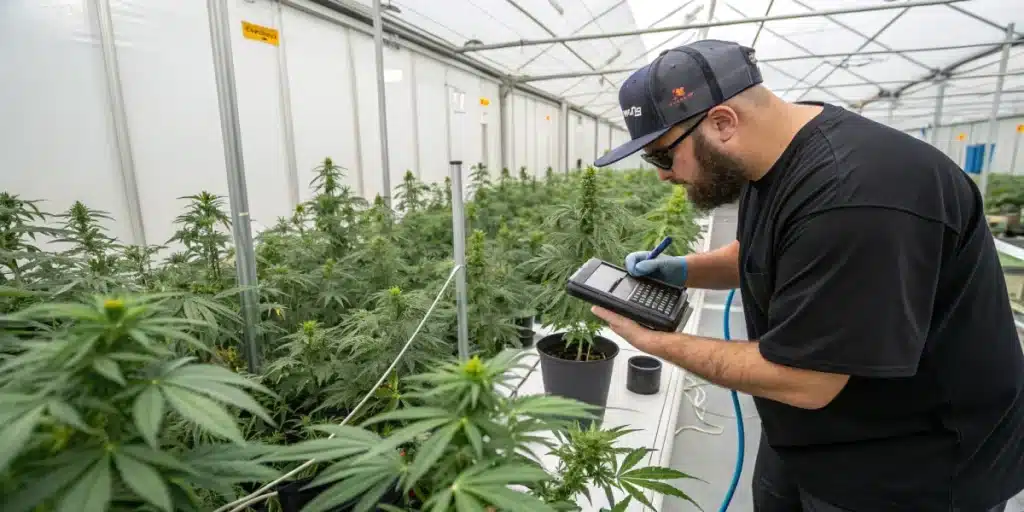
Cannabis Fertilization and Nutrition
Autos like Rainbow Kush require less feeding than photoperiod plants. Start with mild doses (50%) of nitrogen-rich fertilizer early on, and transition to phosphorus and potassium-rich formulas during mid to late flowering. Keep pH between 6.0 and 6.5 for optimal nutrient absorption.
Supplementing with compost teas, worm castings, or other organic additives can improve terpene richness and bud aroma. Monitor plant response and avoid overfeeding, which can burn roots and stunt flower production..
Pest and Disease Control
Inspect plants daily. Autoflowers grow fast, so issues like spider mites or powdery mildew can escalate quickly. Prevent infestations by maintaining airflow (especially indoors), and using organic treatments like neem oil when needed.
Remove any infected leaves immediately and adjust environmental controls if mold or mildew appear. Active vigilance throughout the cycle is critical, as autos don’t give you much time to recover from setbacks.
Rainbow Kush Autoflowering Harvesting and Curing
Unlike photoperiod strains, pistil color in autos isn’t always a reliable indicator they tend to produce new white hairs throughout flowering. Instead, rely on the number of flowering days (according to breeder info) and trichome development to guide your harvest.
When most trichomes are milky with a few amber heads, it’s time. Cut your plants with clean tools and hang them in a dark, ventilated space (60°F–70°F, 50% humidity). Once dry, cure buds in glass jars, opening daily during the first week. Cure for 2–4 weeks for enhanced flavor, smoothness, and potency.
Rainbow Kush Autoflowering Indica or Sativa?
Rainbow Kush Auto is a balanced hybrid with 55% Indica and 45% Sativa. It delivers relaxing physical effects with enough mental clarity to enjoy during the day or evening. This profile is ideal for users seeking relief from arthritis, insomnia, and pain without heavy sedation.
Advantages and Disadvantages
Advantages: Lemon Haze Diesel produces aromatic, resinous buds with a unique citrus-diesel flavor. Its balanced genetics offer an energetic, clear-headed high that is both uplifting and calming. It adapts well to both indoor and outdoor cultivation, and its moderate THC levels make it accessible for beginners.
Disadvantages: The delicate flavor profile requires careful nutrient and environmental management. Yields remain medium, and the plant may need extra branch support during flowering to prevent breakage. These factors demand active attention throughout the growth cycle.
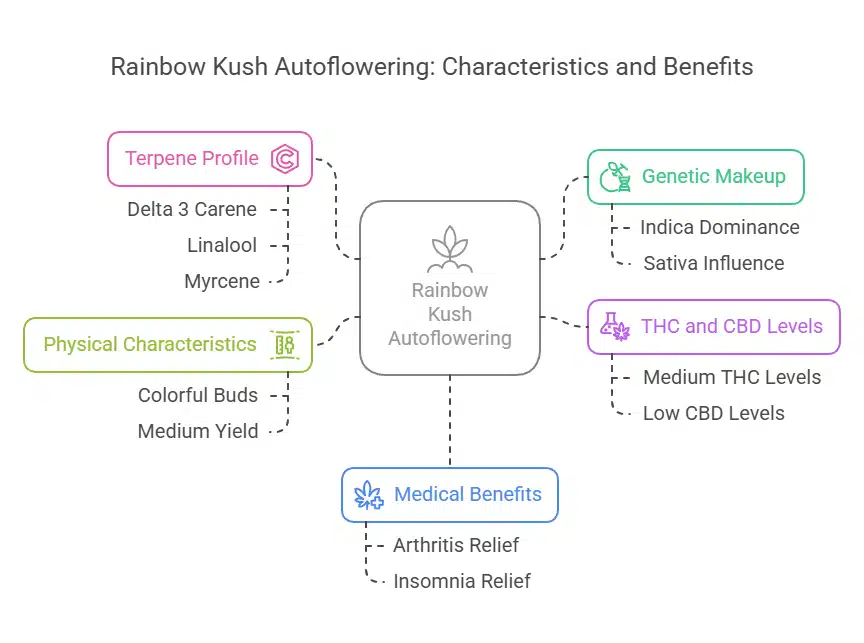
Why Buy Lemon Haze Diesel Weed Strain
Choose Lemon Haze Diesel if you want a strain with a unique blend of citrus and diesel flavors and energizing effects. Its balanced profile is ideal for those looking to relieve conditions like arthritis, insomnia, and pain while enjoying an uplifting experience. Trusted suppliers found in the Blimburnseeds.com catalog offer quality genetics that guarantee a reliable crop. Whether you are a novice or an experienced grower, this strain promises a rewarding and consistent cultivation experience.
Common Growing Problems
Keep an eye on nutrient levels, watering practices, and pest activity throughout the grow. Overfeeding, overwatering, or neglecting environmental controls can stress the plant and reduce yields. Quick, active adjustments to light, temperature, or humidity help prevent common pitfalls. Regular inspections and a steady routine are your best tools for troubleshooting issues before they become major problems.
Similar Strains
Blue Dream
Blue Dream offers a similar fruity flavor and balanced high, making it a popular alternative for those who enjoy a blueberry twist. Its robust growth and consistent yields have earned it a loyal following among indoor and outdoor growers alike.
Haze Auto
Haze Auto is a classic sativa with a spicy, citrus twist. The strain delivers an energizing creative boost that is comparable to Lemon Haze Diesel. Its potent effects and dynamic flavor profile make it a staple in many gardens.
Blueberry
Blueberry stands out for its deep, sweet blueberry aroma and relaxing effects. Its genetics overlap with Lemon Haze Diesel, appealing to growers who value a sweet, fruity experience combined with effective pain relief and relaxation.
Tips for Professionals
Advanced growers use timers, quality sensors, and organic supplements to fine-tune every aspect of cultivation. Keeping detailed logs of light cycles, nutrient adjustments, and environmental changes helps make quick improvements when needed. Advanced training techniques, such as low-stress training (LST) and topping, allow for better light penetration and air circulation, leading to healthier plants and higher yields. Integrating technology with hands-on care ensures that Lemon Haze Diesel consistently produces premium yields and maintains its unique flavor profile.
FAQs
What makes Lemon Haze Diesel unique?
Its refreshing blend of citrus and diesel aromas, paired with a balanced, uplifting high and gentle body relaxation, makes it stand out. The strain’s specific terpene blend offers benefits for pain relief, stress reduction, and improved energy.
How long is the flowering phase?
Under optimal conditions, Lemon Haze Diesel flowers for 8-10 weeks, allowing it to develop dense, resinous buds with a robust flavor profile.
Can I grow it outdoors?
Yes, it thrives outdoors in sunny, nutrient-rich, well-draining soil. Outdoor cultivation benefits from natural light and proper care, with regular watering and wind protection playing key roles.


